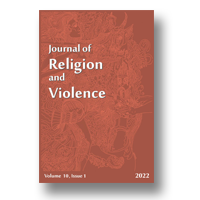|
|
|
1.
|
Journal of Religion and Violence:
Volume >
8 >
Issue: 1
Margo Kitts
Introduction to the Journal of Religion and Violence, Volume 8, Issue 1
view |
rights & permissions
| cited by
|
|
|
|
|
articles |
|
2.
|
Journal of Religion and Violence:
Volume >
8 >
Issue: 1
Zebulon Dingley
The Transfiguration of Lukas Pkech:
Dini ya Msambwa and the “Kolloa Affray”
abstract |
view |
rights & permissions
| cited by
This article explores a violent episode in Kenya’s late-colonial history in which a confrontation between police and members of an anti-colonial religious movement called Dini ya Msambwa resulted an estimated fifty deaths. Drawing on archival documents and interviews with survivors, I reconstruct the event—the “Kolloa Affray,” as it became known—before showing how its violence has been preserved and transformed in the historical theology and ritual practice of the Dini ya Roho Mafuta Pole ya Afrika, which claims to be a continuation of the Msambwa movement. For survivors of the violence itself, and for others who suffered communal punishment in its aftermath, it is an historical wrong for which the British government owes compensation. For the Mafuta Pole faithful, however, the death of Dini ya Msambwa’s leader Lukas Pkech at Kolowa becomes a kind of second crucifixion, “cancelling” the violence of the past and ushering in a new era of forgiveness and reconciliation. The simultaneous preservation and negation of this violent past in Mafuta Pole historical consciousness is shown through an analysis of its discursive, ritual, and memorial practices.
|
|
|
|
|
3.
|
Journal of Religion and Violence:
Volume >
8 >
Issue: 1
Robert Blunt
Anthropology After Dark:
Nocturnal Life and the Anthropology of the Good-Enough in Western Kenya
abstract |
view |
rights & permissions
| cited by
Sherry Ortner has recently described Marxian and Foucauldian inspired anthropological concerns for power, domination, and inequality as “dark anthropology.” In juxtaposition, Joel Robbins has challenged anthropologists to explore ideas of the good life, conceptions of value, and ethics in different ethnographic contexts; what he calls an “anthropology of the good.” Between these poles, this paper attempts an anthropology of the “good enough” to examine beliefs and practices that may partially, and counterintuitively, ground local conceptions of trust in the gray areas of social life. The phenomenon of “nightrunning” amongst the Bukusu of western Kenya, I argue, undergirds a noctural economy of lending and borrowing—rather than theft and victimhood—of reproductive potential; nightrunners remove their clothing at night to “bang their buttocks” against their neighbors’ closed doors and throw rocks at their roofs to prevent them from “sleeping,” a euphemism for sexual intercourse. Due to the way Bukusu understand nightrunners to be sterile unless they “run,” while annoying, they are nonetheless considered deserving of sympathy. Key here is that Bukusu do not necessarily see such seemingly absorptive nocturnal activity as witchcraft. While the identities of nightrunners are protected by the darkness of night—a chronotope which usually indexes witchcraft and political corruption—Bukusu claim that nightrunners are categorically people that one knows “in the light of day.” The paper explores how practices like nightrunning might help us rethink social intimacy and trust.
|
|
|
|
|
4.
|
Journal of Religion and Violence:
Volume >
8 >
Issue: 1
Justin J. Meggitt
The Problem of Apocalyptic Terrorism
abstract |
view |
rights & permissions
| cited by
The concept of “apocalyptic terrorism” has become common in the study of terrorism since the turn of the millennium and some have made considerable claims about its analytical and practical utility. However, it raises substantial problems. Following a brief survey of the way that the idea has been employed, this paper identifies difficulties inherent in its current use. In addition to those of a definitional kind, these include the treatment of “apocalyptic” as a synonym for “religious”; the assumption that apocalyptic is always primary and totalizing; homogenizing claims about the character of apocalyptic radicalism; mistaken assumptions about the causes and character of apocalyptic violence; problematic cross-cultural and non-religious applications of the term “apocalyptic”; the neglect of hermeneutics; and the dearth of contributions by specialists in the study of religion. The argument concludes that there are good grounds for abandoning the notion of “apocalyptic terrorism” entirely, but given that this is unlikely, it should be employed far more cautiously, and a narrower, more tightly defined understanding of the concept should be advocated by those engaged in the study of terrorism.
|
|
|
|
|
book reviews |
|
5.
|
Journal of Religion and Violence:
Volume >
8 >
Issue: 1
Philippe Buc
War and Religion: Europe and the Mediterranean from the First through the Twenty-first Centuries. Arnaud Blin
view |
rights & permissions
| cited by
|
|
|
|
|
6.
|
Journal of Religion and Violence:
Volume >
8 >
Issue: 1
Don J. Wyatt
Religious Culture and Violence in Traditional China. Barend ter Haar
view |
rights & permissions
| cited by
|
|
|
|
|
7.
|
Journal of Religion and Violence:
Volume >
8 >
Issue: 1
Katherine Allen Smith
Nebuchadnezzar’s Dream: The Crusades, Apocalyptic Prophecy, and the End of History. Jay Rubenstein
view |
rights & permissions
| cited by
|
|
|
|
|
8.
|
Journal of Religion and Violence:
Volume >
8 >
Issue: 1
Aaron Ricker
The Fourth Reich: The Specter of Nazism from World War II to the Present. Gavriel D. Rosenfeld
view |
rights & permissions
| cited by
|
|
|
|
|
9.
|
Journal of Religion and Violence:
Volume >
8 >
Issue: 1
John Soboslai
Confronting Religious Violence: A Counternarrative. Richard A. Burridge and Jonathan Sacks, editors
view |
rights & permissions
| cited by
|
|
|
|
